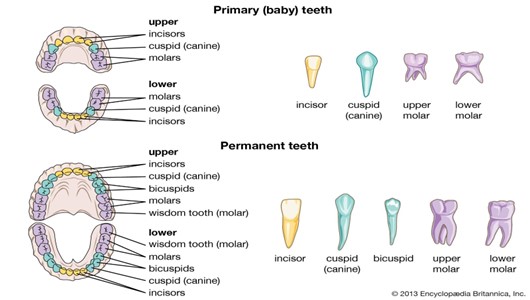Dr. Chandana Annyam (BDS)
Published on - 20 Nov 2023

Every person has two sets of dentitions:
Teeth helps not only aiding in the mastication of food but also playing a pivotal role in both speech and aesthetics. Often, dental issues are overlooked until they reach a critical stage. Each tooth possesses its unique structure and purpose. Therefore, it's essential for everyone to grasp the distinct types and functions of teeth, as well as how to maintain their optimal health.
Primary Dentition is also known as Deciduous dentition or Milk dentition. It comprises of 20 teeth, 5 in each half of the jaw (Incisors 2, Canine 1, Molars 2). Usually, they start erupting from 6 months of age.
Permanent Dentition comprises of 32 teeth, 8 in each half of the jaw (Incisors 2, Canine 1, Premolars 2, Molars 3). The first permanent tooth erupts usually at around 6 years of age.

Incisors: Incisors are flat with thin edges and are used to bite and cut the food into smaller pieces.
Canine: Canines, also known as Cuspids, are sharp and pointed, resembling fangs. These are used to tear the food.
Premolar: Premolars have two cusps, known as Bicuspids. These are used to chew and grind the food.
Molar: Molars are large, bulk with numerous cusps and are used to grind the food. Last tooth to erupt in the oral cavity is Third Molar (Wisdom teeth).
Each type of tooth plays a crucial role in the overall process of mastication (chewing) and helps in the initial breakdown of food for digestion. The combination of these different types of teeth allows for the effective processing of various textures and types of food.
Now that you've gained the knowledge about the different types of teeth and their functions, you shouldn't overlook any of them because each one is important in its own way. Make it a habit to brush your teeth twice a day and visit the dentist on a regular basis..
Published on - 20 Nov 2023
This article is intended to promote understanding of and knowledge about general oral health/ treatment topics. It is not intended to be a substitute for professional advice, diagnosis or treatment. Always seek the advice of your dentist or other qualified healthcare provider with any questions you may have regarding a medical condition or treatment.